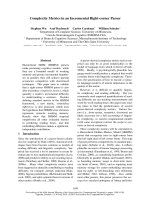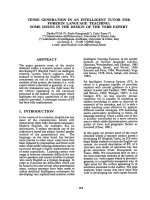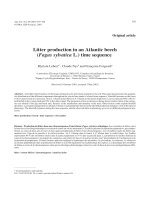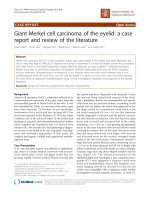báo cáo khoa học: "Precocious puberty in an infant with hepatoblastoma: a case report" doc
Bạn đang xem bản rút gọn của tài liệu. Xem và tải ngay bản đầy đủ của tài liệu tại đây (892.47 KB, 4 trang )
CASE REP O R T Open Access
Precocious puberty in an infant with
hepatoblastoma: a case report
Usama Al-Jumaily
1*
, Ibrahim Sammour
1
, Fadi Al-Muhaisen
1
, Fatenah Ajlouni
2
and Iyad Sultan
1
Abstract
Introduction: The syndrome of isosexual precocious puberty associated with primary malignant hepatic tumors is
rare. All previously reported cases in the literature are old and prognosis was grim.
Case presentation: We present the case of a 15-month-old Asian male baby who presented with precocious
puberty associated with hepatoblastoma. Serum concentrations of alpha-fetoprotein and free testosterone were
elevated, as was beta human chorionic gonadotropin hormone. He was treated with six courses of chemotherapy
and underwent surgery. His surface markers as well as free testosterone level returned to normal during therapy.
The child has now been off therapy for 18 months with no evidence of tumor recurrence at follow-up.
Conclusion: Virilizing hepatoblastoma is rare and reported with poor outcome, but the development of new
chemotherapeutic agents and complete surgical resection are promising.
Introduction
Hepatoblastoma is the most commo n pediatric hepatic
tumor. Using the current modalities of treatment, non-
metastatic hepatoblastoma usually carries a favorable
prognosis if completely resected. The tumor typically
secretes a-fetoprotein (AFP) which is a useful marker
for management and follow-up. On rare occasions,
hepatoblastoma is associated with beta human chorionic
gonadotropin hormone (b-hCG) secretion [1].
Paraneoplastic features of hepatoblastoma are not
uncommon at presentation and include thro mbocyt osis
and increased alkaline phosphatase [2]. Occasionally,
isosexual precocious puberty was reported in boys with
hepatoblastoma [1,3-15]. While most cases were
reported in the 1980s, we believe documenting the
response of similar cases to treatment in the modern
era is important.
Case presentation
A 15-month-old Asian male baby presented to our cen-
ter with precocious puberty and a hepatic mass. He was
a product of cesarean section at 37 weeks of gestation.
He had meconium aspiration at birth but had no history
of hypoglycemia. His bi rth weight was 3. 75 kg ( in the
75
th
centile). At the age of eight months his mother
noticed enlarging genitalia with sparse pubic hair and
changes in his voice. These symptoms p rogressed over
time and six months later, he started to have persistent
fever and abdominal distension. A right upper quadrant
mass was palpable at that time, so he was referred for
evaluation. His family history was significant for an
older sibling who died after being diagnosed with
Wilms’ tumor at the age of ten years and for a grand-
parent who died of lung cancer. There was no family
history of overgrowth syndrome or other pediatric
tumors. His parents were not related by blood.
At the time of presentation, his height was 82 cm (in
the 90
th
centile for age) and his weight was 12.45 kg (in
the 95
th
centile). There was no ev idence of hemi hyper-
trophy or dysmorphic features. He had a large-for-age,
uncircumcised penis that measured 10 cm from the
base with a large thick scrotum and scarce suprapubic
hair (Tanner stage was III, as seen in Figure 1). A
workup revealed a bone age of two years and eight
months and blood investigations showed elevated AFP
(356,474 ng/mL, normal for age < 12 ng/mL), b-hCG
(13.7 mIU/mL, normal for age < 2 mIU/mL), and free
testosterone (10 pmol/L, normal for age 0.09-5.4 pmol/
L) along with thrombocytosis (platelet count of 1244 ×
10
3
/μl). An abdominal ultrasound revealed a right
* Correspondence:
1
Department of Pediatric Oncology, King Hussein Cancer Center, Queen
Rania Al Abdullah St, Amman, 11941, Jordan
Full list of author information is available at the end of the article
Al-Jumaily et al. Journal of Medical Case Reports 2011, 5:422
/>JOURNAL OF MEDICAL
CASE REPORTS
© 2011 Al-Juma ily et al; licensee BioMed Central Ltd. This is an Open Access article distributed und er the terms of the Creative
Commons Attribution License ( g/licenses/by/2.0), which permits unrestricted use , distribution, and
reproduction in any medium, provided the origi nal work is properly cited.
hepatic lobe mass. A computed tomography (CT) scan
(Figure 2) showed a large heterogeneously enhancing
right hepatic lobe measuring 10.5 × 11.5 cm and invol-
ving mainly segment VII and parts of segments V, VI
and VIII in keeping with a 2-sector involvement with
inferior vena cava (IVC) extension almost reac hing his
right atrium (PRETEXT II-V3). A metastatic work-up
showed no metastasis to his lung. Other hormonal
laboratory tests, including serum prolactin (16.69 ng/
mL, normal for age 4.1-18.4 ng/mL), androstenedione
(0.6 ng/mL, normal for age 0.3-3.5 ng/mL), dehydroe-
piandrosterone sulfate (0.182 μmol/L, normal for age
0.9-11.7 μmol/L), thyroid stimulating hormone (3.7
mIU/L, normal for age 0.3-5 mIU/L), free thyroxin (1.4
ng/dL, normal for age 0.71-1. 85 ng/dL), free triiodo-
thryronine (0.44 pg/mL, no rmal for age 1.45-3.48 pg/
mL), follicular stimulating hormone (0.5 IU/L, normal
for age 1-8 IU/L), luteinizing hormone (1.08 mIU/mL,
normal for age 5-12 mIU/mL), and a gonadotrophin
releasing hormone test, were all within normal range for
age. Brain m agnetic resonance ima ging did not detect
any abnormality in his brain or pituitary gland. A testi-
cular ultrasound (US) appeared normal and unremark-
able. A testicular biopsy was not done.
Our patient was treated with four cycles of preoperative
chemotherapy (cisplatin, alternating with carboplatin/dox-
orubicin). The tumor showed a good partial response with
more than 50% reduction in the size of the mass and a
resolved IVC thrombus. Doppler US confirmed patency of
thehepatic,portalandIVCveins.Duringtherapy,we
observed a decline in the level of free testosterone (Table
1) with an arrest of further virilization. Our patient under-
went surgery with complete excision of the tumor, fol-
lowe d by two additional chemotherapy cycles containing
cisplatin. A p athology review (Figure 3) showed residual
hepatoblastoma with 90% necrosis. The viable part showed
fetal histology and stained positively for Hep Par1 and
CD34. The resection margins were free of tumor and
there was absence of blood vessel invasion. Laboratory and
radiologic evaluation revealed no evidence of tumor recur-
rence one and a half years after completion of therapy.
Our patient was 33 months old on the last visit and no
further development of secondary sexual signs were eli-
cited. His height was 96 cm (between the 50
th
and 75
th
centile) and his weight was 14.2 kg (at 50
th
centile).
Discussion
Isosexual precocious puberty due to a virilizing hepato-
blastoma is a rare but well documented occ urrence
Figure 1 Photograph of patient’s genitalia at 15 months of
age. Shows large pigmented scrotum (light arrow), scant pubic hair
[not clear on the picture] (dark arrow) and penile enlargement (10
cm stretched length).
Figure 2 CT scan of the liver showing the hepatic tumor. (A) Involvement of the right hepatic lobe; (B) area calcification and IVC extension.
Al-Jumaily et al. Journal of Medical Case Reports 2011, 5:422
/>Page 2 of 4
[1,3-15]. Cases have been confined to boys, generally
below three years of age, who have usually presented
with accelerated skeletal growth and virilization [4].
Hepatic enlargement at presentation has been invariable.
Two hypotheses explaining androgen secretion are sug-
gested in the literature: ectopic testosterone secretion
and secondary testosterone secretion. The first theory
suggests excess secretion of testosterone by neoplastic
cells [4], while the second theory suggests secondary sti-
mulation of the testes by b-hC G [3,4,7,8]. While it
remains difficult to speculate as to which may be the cor-
rect theory, it is interesting to notice that virilization
occurred in all reported children with hepatoblastoma in
association with elevated b-hCG levels, supporting the
role of this hormone in excessive androgen production.
Central and secondary precocious puberty such as
hypothyroidism, premature adrenarche and congenital
adrenal hyperplasia were first excluded by performing the
appropriate tests. Together with ele vated b-hCG levels
and the findings of imaging studies, the correct diagnosis
was suspected and proper therapy was initiated.
The majority of the previous cases were reported
more than two decades ago, making it difficult to judge
the outcome of virilizing hepatoblastoma, taking into
consideration the inferior quality of imaging techniques,
surgical techniques and chemotherapeutic regimens. As
a matter of fact, it was suggested that virilizing hepato-
blastoma carried a worse outcome when compared to
nonvirilizing tumors, alluding to a unique biological
setup [ 8]. Our patient’s response to therapy was favor-
able. His initial presentation with IVC thrombosis had
put him at a higher risk for local failure; however, the
favorable response to chemotherapy and complete resec-
tion is reassuring.
Conclusions
Although isosexual precocious puberty with hepatoblas-
toma is rare and carries a poor outcome (as reported in
most cases), results due to developments in chemothera-
peutic agents and complete surgical resection are
promising.
Consent
Written informed consent was obtained from the
patient’s legal guardian (father) for publication of this
case report and any ac companying images. A copy of
the wr itten consent is available for review by the Editor-
in-Chief of this journal.
Author details
1
Department of Pediatric Oncology, King Hussein Cancer Center, Queen
Rania Al Abdullah St, Amman, 11941, Jordan.
2
Department of Radiology,
Table 1 Results of laboratory investigations during and after treatment
AFP (ng/mL) b-hCG (mIU/mL) Free testosterone (pmol/L)
Normal values for age < 12 < 2 0.09-5.4
At time of presentation 356,474 13.7 10
After first chemotherapy cycle 78,077
After second chemotherapy cycle 7062 < 2
After fourth chemotherapy cycle 67.52 4.5
After surgery 10.6 < 2
At end of therapy 5.1 < 2 0.1
Follow-up six months after end of therapy 3.76 < 2
Figure 3 Postsurgical histopathology showing chemotherapy effect. (A) Fibrosis, hyalinization and myxomatous changes seen in 30% of the
tumor size; (B) free surgical resection margin; (C) background of mixed epithelial mesenchymal hepatoblastoma with a predominant epithelial
subtype.
Al-Jumaily et al. Journal of Medical Case Reports 2011, 5:422
/>Page 3 of 4
King Hussein Cancer Center, Queen Rania Al Abdullah St, Amman, 11941,
Jordan.
Authors’ contributions
UA interpreted the patient data and was a major contributor to the writing
of the manuscript. IS and FAM collected the clinical data. FA obtained and
interpreted radiological studies. UA and IS reviewed the literature. IS gave
approval for the final manuscript. All authors read and approved the final
manuscript.
Competing interests
The authors declare that they have no competing interests.
Received: 18 May 2011 Accepted: 30 August 2011
Published: 30 August 2011
References
1. Braunstein GD, Bridson WE, Glass A, Hull EW, McIntire KR: In vivo and in
vitro production of human chorionic gonadotropin and alpha-
feteoprotein by a virilizing hepatoblastoma. J Clin Endocrinol Metab 1972,
35(6):857-862.
2. Komura E, Matsumura T, Kato T, Tahara T, Tsunoda Y, Sawada T:
Thrombopoietin in patients with hepatoblastoma. Stem Cells 1998,
16(5):329-333.
3. Arshad RR, Woo SY, Abbassi V, Hoy GR, Sinks LF: Virilizing hepatoblastoma:
precocious sexual development and partial response of pulmonary
metastases to cis-platinum. CA Cancer J Clin 1982, 32(5):293-300.
4. Galifer RB, Sultan C, Margueritte G, Barneon G: Testosterone-producing
hepatoblastoma in a 3-year-old boy with precocious puberty. J Pediatr
Surg 1985, 20(6):713-714.
5. Heinrich UE, Bolkenius M, Daum R, Oppermann HC, Mehls O, Brandeis WE:
Virilizing hepatoblastoma–significance of alpha-1-fetoprotein and
human chorionic gonadotropin as tumor markers in diagnosis and
follow-up. Eur J Pediatr 1981, 135(3):313-317.
6. Herlin T, Norup K, Storm K: Treatment of unresectable hepatoblastoma
with cisplatin, vincristine and 5-fluorouracil. Eur J Pediatr 1988,
147(5):514-515.
7. Kumar EV, Kumar L, Pathak IC, Dash RJ, Joshi VV: Clinical, hormonal and
ultrastructure studies of a virilizing hepatoblastoma. Acta Paediatr Scand
1978, 67(3):389-392.
8. Nakagawara A, Ikeda K, Tsuneyoshi M, Daimaru Y, Enjoji M, Watanabe I,
Iwafuchi M, Sawada T: Hepatoblastoma producing both alpha-fetoprotein
and human chorionic gonadotropin. Clinicopathologic analysis of four
cases and a review of the literature. Cancer 1985, 56(7):1636-1642.
9. Flores F, Solano A, Rebeil R, Osuna JA, López M, Romero CA, García E:
Isosexual precocious puberty in a male infant with hepatoblastoma. Rev
Invest Clin 1979, 31(3):251-255.
10. Butenandt O, Knorr D, Hecker WC, Löhrs U: Precocious puberty in a boy
with HcG-producing hepatoma. Case report. Helv Paediatr Acta 1980,
35(2):155-163.
11. Morinaga S, Yamaguchi M, Watanabe I, Kasai M, Ojima M, Sasano N: An
immunohistochemical study of hepatoblastoma producing human
chorionic gonadotropin. Cancer 1983, 51(9):1647-1652.
12. Beach R, Betts P, Radford M, Millward-Sadler H: Production of human
chorionic gonadotrophin by a hepatoblastoma resulting in precocious
puberty. J Clin Pathol 1984, 37(7):734-737.
13. Navarro C, Corretger J, Sancho A, Rovira J, Morales L: Paraneoplasic
precocious puberty report of a new case with hepatoblastoma and
review of the literature. Cancer 1985, 56(7):1725-1729.
14. Watanabe I, Yamaguchi M, Kasai M: Histologic characteristics of
gonadotropin-producing hepatoblastoma: A survey of seven cases from
Japan. J Pediatr Surg 1987,
22(5):406-411.
15. Bode HH, Schimana W, Swai B, Bode U: Sexual precocity associated with
an abdominal tumor in an African boy. J Pediatr Endocrinol Metab 2008,
21(3):275-277.
doi:10.1186/1752-1947-5-422
Cite this article as: Al-Jumaily et al.: Precocious puberty in an infant
with hepatoblastoma: a case report. Journal of Medical Case Reports 2011
5:422.
Submit your next manuscript to BioMed Central
and take full advantage of:
• Convenient online submission
• Thorough peer review
• No space constraints or color figure charges
• Immediate publication on acceptance
• Inclusion in PubMed, CAS, Scopus and Google Scholar
• Research which is freely available for redistribution
Submit your manuscript at
www.biomedcentral.com/submit
Al-Jumaily et al. Journal of Medical Case Reports 2011, 5:422
/>Page 4 of 4









